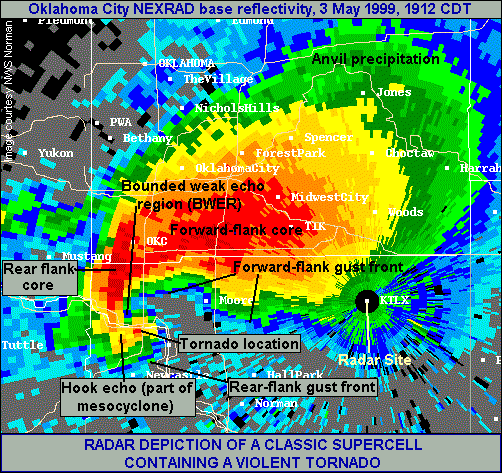
Hook echo
Encyclopedia

Tornado
A tornado is a violent, dangerous, rotating column of air that is in contact with both the surface of the earth and a cumulonimbus cloud or, in rare cases, the base of a cumulus cloud. They are often referred to as a twister or a cyclone, although the word cyclone is used in meteorology in a wider...
-producing supercell
Supercell
A supercell is a thunderstorm that is characterized by the presence of a mesocyclone: a deep, continuously-rotating updraft. For this reason, these storms are sometimes referred to as rotating thunderstorms...
thunderstorms as seen on a weather radar
Weather radar
Weather radar, also called weather surveillance radar and Doppler weather radar, is a type of radar used to locate precipitation, calculate its motion, estimate its type . Modern weather radars are mostly pulse-Doppler radars, capable of detecting the motion of rain droplets in addition to the...
. The echo is produced by rain
Rain
Rain is liquid precipitation, as opposed to non-liquid kinds of precipitation such as snow, hail and sleet. Rain requires the presence of a thick layer of the atmosphere to have temperatures above the melting point of water near and above the Earth's surface...
, hail
Hail
Hail is a form of solid precipitation. It consists of balls or irregular lumps of ice, each of which is referred to as a hail stone. Hail stones on Earth consist mostly of water ice and measure between and in diameter, with the larger stones coming from severe thunderstorms...
, or even debris being wrapped around the supercell. The National Weather Service
National Weather Service
The National Weather Service , once known as the Weather Bureau, is one of the six scientific agencies that make up the National Oceanic and Atmospheric Administration of the United States government...
considers the presence of a hook echo as sufficient to justify issuing a tornado warning
Tornado warning
A tornado warning is an alert issued by government weather services to warn that severe thunderstorms with tornadoes may be imminent. It can be issued after a tornado or funnel cloud has been spotted by eye, or more commonly if there are radar indications of tornado formation...
.
The hook echo has been recognized as a sign of tornado development for most of weather radar's existence. The first documented tracking of a hook echo was on April 9, 1953 by the Illinois State Water Survey, during preparations for an early test of radar's ability to measure rainfall rates.
Hook echoes are not always obvious. In the U.S. Southern states, thunderstorms tend to produce heavier rainfall which leads to the high precipitation (HP) variation supercell and obscures the hook shape. HP supercells will instead take on a kidney bean shape.
The use of doppler weather radar systems such as NEXRAD
NEXRAD
NEXRAD or Nexrad is a network of 159 high-resolution Doppler weather radars operated by the National Weather Service, an agency of the National Oceanic and Atmospheric Administration within the United States Department of Commerce...
allows for detection of tornadoes even when the hook echo is not present, and for greater certainty when it is. By detecting the relative velocities of different parts of a storm, doppler radar can detect areas of rotation.
See also
- Bow echoBow echoA bow echo is a term describing the characteristic radar return from a mesoscale convective system that is shaped like an archer’s bow. These systems can produce severe straight-line winds and occasionally tornadoes, causing major damage.-Research:...
- Bounded weak echo region
- Tornado vortex signatureTornado vortex signatureA tornado vortex signature or tornadic vortex signature, abbreviated TVS, is a Doppler weather radar detected rotation algorithm that indicates the likely presence of a strong mesocyclone that is in some stage of tornadogenesis...
- Convective storm detectionConvective storm detectionConvective storm detection is the meteorological observation of deep, moist convection and consists of detection, monitoring, and short-term prediction. This term includes the minority of storms which do not produce lightning and thunder. Convective storms can produce tornadoes as well as large...
External links
- Hook Echo - AMS Glossary of Meteorology

